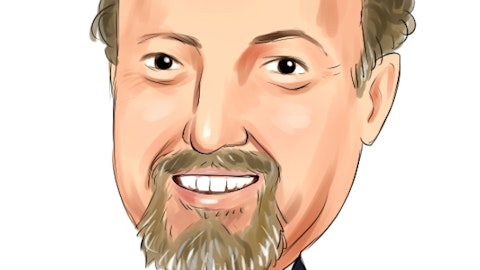Craig Siegenthaler : So my question is on your commentary around building momentum and line of sight into significant fundings, so if we exclude fee rate issues like divergent beta, when do you think BlackRock can get back to 5% base fee organic growth? And with the law of large numbers as a factor, what is your confidence that this objective is still achievable at your current $10 trillion AUM size?
Laurence Fink : Martin?
MartinSmall : It’s Martin. Listen, I’d start by like Q1 net flows were solid at $76 billion. And on a more granular look, we just see durable growth in that flows mix. We had about $100 billion across ETFs, retail, institutional active, institutional fixed income. Of course, we saw some of these $19 billion redemptions from cash with the Good Friday quarter-end dynamic and the $26 billion rebalanced away in institutional index equities. You know those institutional index equities happen from time to time. They’re not meaningful revenue impacts or fee rate detractors, but they weigh on kind of the long-term flow totals. When we look at this core momentum on flows, excluding the episodic index redemptions, Q1 flows were $100 billion.
It’s a healthy trajectory. It’s an affirmation for us that we’re focused on the right things to grow with clients. And on base fees, the management team here, we really feel like we’ve turned a corner. Over the last two quarters, we see really solid trends in organic fee growth. They’re really some of the best since the end of 2021. We saw excellent momentum to finish the fourth quarter, which we talked about on the last call. We closed out in November and December higher than target. And this quarter, March new base fees annualized at target after we had a slower start. So over the last six months, we see organic base fee growth ticking up and trending more halfway or halfway plus to our long-term targets. It’s not a straight line, but we’re moving to target.
And I say this because we see key positive trends in this sort of critical base fee growers for us. Retail posted $7 billion of flows in that 40 basis point to 50 basis point bucket. Money is going back to work, redemption rates are moderating. We see really excellent momentum in active overall with $15 billion of flows and good velocity in institutional and retail active fixed income, in particular, at $9 billion. And I think what Larry is getting at, we’ve been selected for a breadth of mandates across investment management and technology that we see supporting 5% organic growth and will fund over future quarters. Our planned acquisition of GIP will help us build and bump from there. So we look forward to closing that transaction, executing on these mandates and keeping you guys posted on our progress.
Laurence Fink : I would just add, the breadth of conversations we’re having with clients worldwide. Rob Kapito right now is in Asia, the type of conversations we had there. The opportunities we see in Europe, in the U.K., Middle East. These are just very large opportunities, large mandates, big opportunities. And if you then overlay the opportunities and you overlay what infrastructure can do related to the build-out of power with all the AI promise and the need for data centers and the need for power is going to be extraordinary. And all of this is going to lead to much bigger opportunities. And then more importantly, more and more clients are going to be seeking those organizations who deliver the proprietary differentiated products.
Operator: We’ll go next to Michael Cyprys with Morgan Stanley.
Michael Cyprys : Just wanted to ask about balancing investment spend with margin expansion. In the past, we’ve heard BlackRock talked about being margin aware. So, just curious how the thinking of that has evolved. What does that mean in today’s environment? And how might you quantify the opportunity for margin expansion over time? How do you see some of the levers to achieve that?
Martin Small : Our approach to shareholder value creation is obviously to generate differentiated organic growth, it’s to drive operating leverage in a premium margin and it’s to execute on a consistent capital management strategy. We have a strong track record of investing in our business for growth and scale and expanding profitability. And I want to emphasize, it’s not just about growth. It’s about profitable growth over the long-term. And that growth comes from making continued investments in our business. And I’ve talked a lot about on the last several calls and obviously, some of the other meetings we’ve had, we’re looking to size our operating investments in line with the prudent lens on organic growth potential. We’re aiming to put more flexibility in our cost base and variabilize expenses where we can.
And most importantly, we’re looking to generate fixed cost scale, especially through investments in technology. We’re consistently delivering industry leading margins, which is a goal and we’ve expanded our margin in six out of the last 10 years. And I think those scale indicators are coming through in our results. We’re delivering profitable growth. We generated 180 bps of margin expansion year-on-year, while revenue op income and EPS all rose double-digits. And we delivered 60 basis points of sequential margin improvement. Over the last 18 months, AUM is up $2.5 trillion, while headcount is actually flat or slightly lower. So I feel like we’re delivering benefits of scale and productivity, which is showing in margin expansion. As I mentioned, we’re planning for full year low to mid-single digits core G&A growth, flat headcount both excluding the GIP transaction.
So you’ve heard on our last few calls and I hope today and some of Larry’s color, we’re looking to drive more fixed cost scale. That comes from technology. It comes from automation. It can come from AI. It comes from organizational design, global foot printing using some of our innovation hubs around the world. We see those as our major levers to drive margin expansion. And in the end, we’re just looking to optimize organic growth in the most efficient way possible, deliver growth for clients and shareholders and ultimately expand our margin over time.





